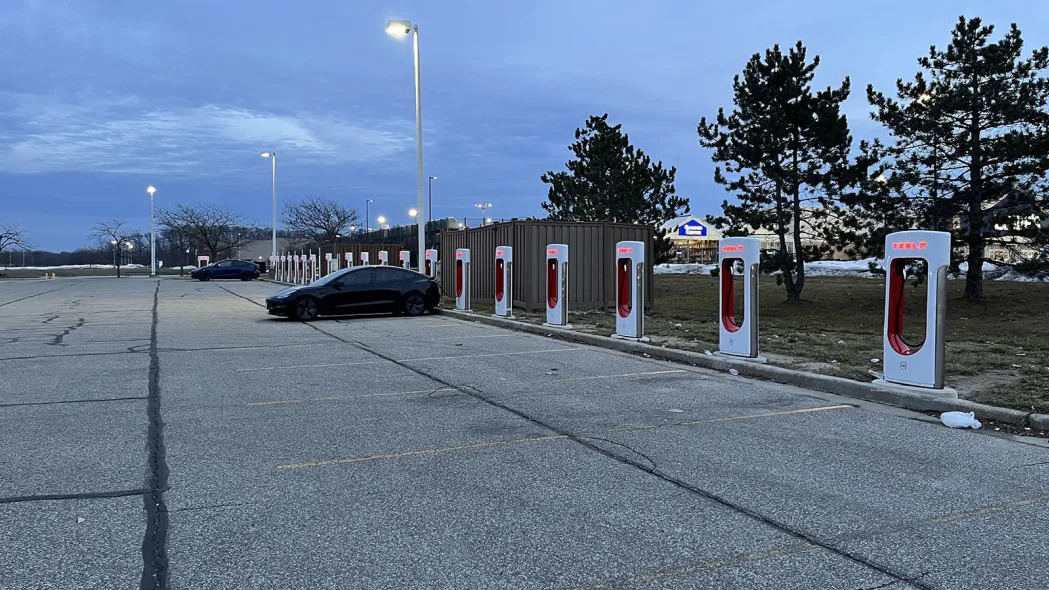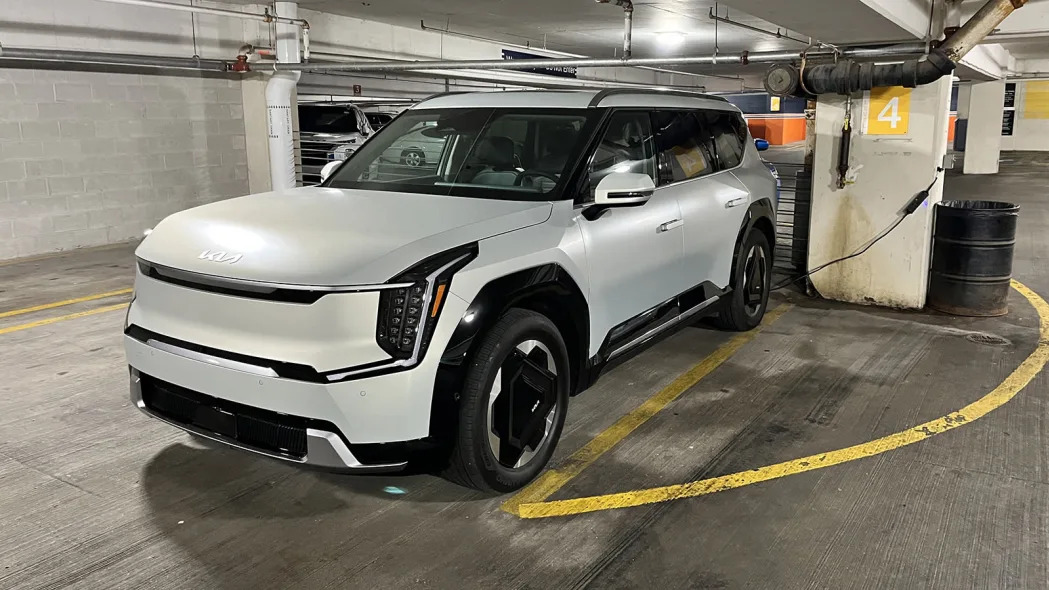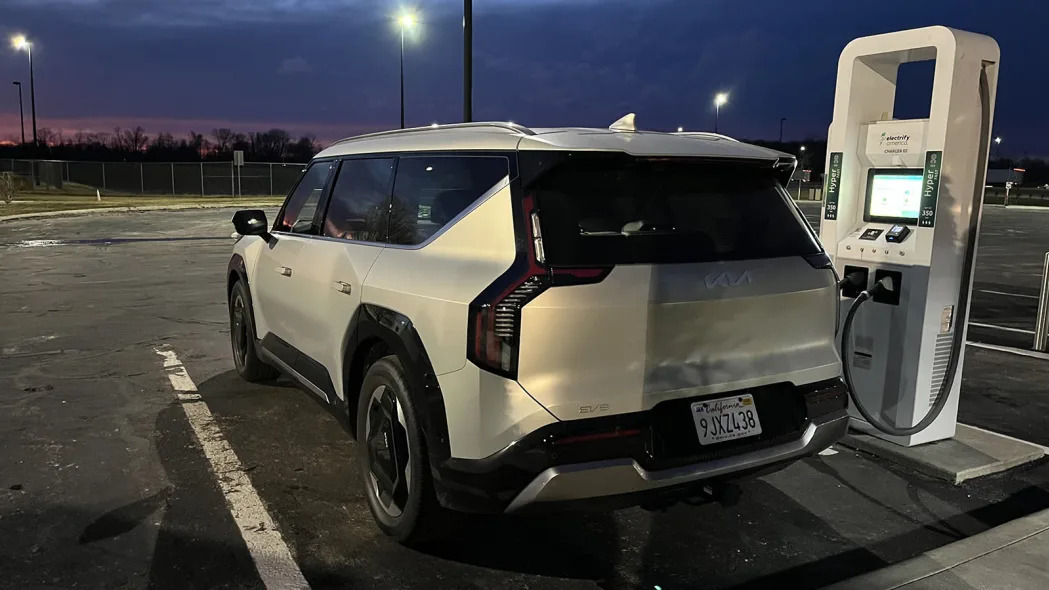580 miles, 0 problems. How I drove an EV to Chicago stress-free

Just before the Chicago Auto Show, I messaged Road Test Editor Zac Palmer to ask if I could get a test car to drive out to the event. He came back with two options that were coming in that week: a Mazda CX-90 PHEV and a Kia EV9. Keep in mind, the Chicago Show is in February, and the trip from Detroit takes place mostly in southern Michigan or northern Indiana, depending on your route. Either way, it would most likely be cold. And the distance would be around 290 miles one way, or 10 more than the estimated maximum range of the EV9 Land AWD offered.
Even in a gas car, I’d have to refuel at some point in the round trip journey, but obviously that would be trivial. So the clear choice for hassle-free driving was the Mazda. And yet, for some reason that I still don’t completely understand, I felt adventurous when Zac sent me the options, and I told him to book me time in the Kia. Even as I typed in my response and hit “send,” I was thinking, “Are you really sure about this? This could turn into a massive headache.” I kept staring at my Slack app. But I stuck to my guns. I would pilot the EV9. And guess what? I got a glimpse at how totally uninteresting an EV road trip could be, and it was truly beautiful.
The trip also sort of started before it, well, started. Between the EV9’s delivery and driving it around a bit for errands and dropping off my dog with my parents (he’s shown above, eager to start the drive), the charge level had dipped below 50%. I still haven’t added a 240-volt Level 2 charger to my house (which is something I would absolutely do if I actually owned an EV, and is still on the to-do list considering my work). So I needed to run it over a couple of miles to my local Meijer, which is home to 350-kilowatt and 150-kilowatt EVGo charging stations. While I was hoping to grab one of the 350s to take advantage of the Kia’s seriously fast charging capabilities, it was apparently a busy night for charging. Both 350s were taken, including one by a Chevy Bolt EV whose owner apparently doesn’t understand that a 350-kW charger will be no better for their car than the very-much-open 150-kW one next spot over. At least all the chargers were working.
After backing up to the slower charger, I braced myself for another possible hurdle: payment. This is one of my biggest peeves. And I need to preface this by noting that we have the payment and refueling process solved with gas stations. You pull up, you swipe your card, you fill up. It’s that simple, and it works every time. You don’t have to sign up for an app for Shell, ExxonMobil, Marathon, BP, Speedway, and many, many more to start up and pay for your fuel. And I bring this up, because so many times, I’ve pulled up to a charger, and the credit card reader is not functioning. Which then means I have to bust out my phone, find the app for the charger, find the charger, and activate it from there. And that’s if I have the app already and don’t have to sign up for it.
That night at Meijer, though, I just plugged into the EV9’s charge port, and the station immediately recognized it was connected to the car. It then swiped my card, and after a few moments, clicks and whirrs, the screen confirmed the EV9 was in fact charging. This is obviously how you’d expect it to go every time, yet no part of the above is guaranteed to work with any regularity. After a leisurely 30 to 45 minutes of grocery shopping, I came back out to find the car charged up to around 80%. I stuck around another 15 minutes or so to get it to 90% and then went home and plugged into 120 volts to finish it off overnight. It was a shockingly promising start to the trip.

To help make sure that became I trend, I did some light research to figure out where best to recharge en route to Chicago. Available in browsers and as an app, PlugShare provides detailed information on the locations of a wide variety of chargers from different chains and of various power levels. It was extremely helpful to be able to view basically everything on the route, and to be able to filter out slower chargers and ones with connectors that might not work for me. I decided I would stop at yet another Meijer, approximately 230 miles away near Michigan City, Ind., where there were Electrify America chargers with full 350-kW charging capability. That Meijer also had loads of Tesla Superchargers (shown above), but without an adapter or a Tesla charging account, I was ruling those out.
The next day, I loaded up the EV9 and found the range estimate to be between 260 and 270 miles. Fortunately, we had a bit of a warm spell, resulting in temperatures in the high 40s and low 50s for the drive. As such, the batteries weren’t too cold and I wouldn’t have to rely so much on the heater, all good news for range. I left the car in Eco mode just to be safe and ensure that maximum range estimate, and began my journey like any other road trip.
Though I stopped on occasion to grab snacks and use the bathroom, the big stop would obviously be the pre-planned pit near Michigan City. As I neared, the car was repeatedly warned of the battery being below 20%, and I even saw a warning that maximum motor power was reduced at one point. Fortunately, whatever power reduction was in effect still left the EV9 more than comfortable driving at highway speeds or needing to accelerate. So if you see such a warning in your own example, don’t panic.
Admittedly, there was still some concern building in the back of my mind. I was going to get to Michigan City with just under 10% charge, and if I arrived to find malfunctioning chargers or a row of near-empty Bolts, I was in a tough spot. Miraculously, I pulled into that Meijer parking lot to find a bank of green-glowing Electrify America stations, all 350s and seemingly all functional. Just as with the EVGo station the night before, I plugged in, tapped my card and, as the EV9 literally says out its front speaker, “charging started.” The estimated time to 80% said about a half hour, and by the time I went into the Meijer, used the restroom and purchased some snacks, that 80% had in fact arrived. Again, I stuck around for a few more minutes to squeeze in some more electrons, which seemed like a good idea since I wasn’t completely sure what the charging situation would be at the McCormick Place Hyatt Regency. With a huge excess of power to complete my journey, I soldiered on to the home of Soldier Field without a care in the world.

Pulling into the hotel parking garage, I was a bit disappointed to see no Level 2 chargers about for somewhat slower charging. But I spotted that someone, clearly another journalist as it was a press vehicle, had found a standard 120-volt household outlet to plug in a slow AC charger. As my EV9 had a charging cord in the cargo area – a standard feature on the EV9 – I proceeded to do the same, leaving it plugged for the entirety of my time in Chicago, ensuring I would have a full battery for my return trip.
That would include a detour to pick up my dog in Indiana, so a different route would be in order. Using PlugShare, I picked a service plaza on the Ohio Turnpike just 195 miles away from Chicago. This would give me a little extra buffer in case the worst happened and I couldn’t charge there. Thankfully, I had the same flawless experience as my previous stops, including returning from a fast food dinner break to find the EV9 back up to 80%. That amount of range meant I could finish my trip without any more charging stops.

I learned a number of things from this trip, all of which point to the fact that EV transportation actually has the potential to be stress-free, and it’s not as far off as it might seem.
For one thing, we actually have charging speeds that are more than acceptable for road trips. No, fueling is not as fast as the 5 to 10 minutes of filling a gas tank. But there’s a key advantage that isn’t usually mentioned: You don’t have to be with the car while it’s filling up. When you’re on a road trip, there’s a good chance you’re still going to pop into the shop to recharge yourself (or drain). Even if you’re really quick, you’re often looking at about 15 minutes in total, maybe 20-30 if you’re waiting on others. As I only needed about 30 minutes in the EV9 to charge to 80% on each stop, recharging didn’t really add any extra time to my drive and was just as convenient. I was even able to refuel at my destination, something you can’t do with a gas car, though dedicated destination chargers are obviously preferable to mooching off the hotel and hoping no one unplugs you.
Planning my trip was pretty easy, too. It wasn’t as carefree as simply punching in my final destination and just filling up when I felt like stopping, but I only ever had to use one site and then my phone’s navigation app (though Kia’s is quite good and starts suggesting charging stations when you approach 20%). I did NOT need to have 10 different apps to charge along the way because I could simply pay with my card. You know, the thing I use to purchase goods and services from literally every other physical retail place in the country.
I experienced the best-case scenario of road tripping with an EV. This is how it’s supposed to work and one assumes will work as the infrastructure continues to be built out. Of course, this is not how it typically goes today. Some combination of charger malfunctions, payment difficulties and crowded stations is still unfortunately the norm, with the prospect of poor weather conditions adding yet another layer. We’re obviously not there yet, but this trip shows that carefree EV road tripping is not fantasy, it can be a reality. Not a common enough reality, but a reality nonetheless. I’m feeling more excited and optimistic that as dependability and availability improves, EV life will be as pleasant, if not more so, than internal combustion life.
Related video:







